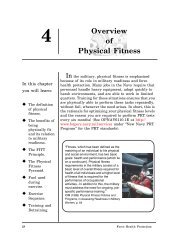TM 11240-15/3F MT Licensing Official Manual - Marine Corps Base ...
TM 11240-15/3F MT Licensing Official Manual - Marine Corps Base ...
TM 11240-15/3F MT Licensing Official Manual - Marine Corps Base ...
Create successful ePaper yourself
Turn your PDF publications into a flip-book with our unique Google optimized e-Paper software.
APPENDIX D<br />
DEFINITIONS<br />
D-1. GENERAL. The following definitions are organized according to subject area.<br />
<strong>TM</strong> <strong>11240</strong>-<strong>15</strong>/<strong>3F</strong><br />
D-2. VEHICLE TYPES. OF 346 Operator’s Permits differ according to the type of<br />
vehicle(s) which an applicant is qualified to operate. The following general definitions apply to<br />
the various classifications of vehicles and types of equipment.<br />
a. Commercial Vehicles. Standard commercial production models that have no<br />
military design features. These vehicles are normally used to provide logistics and<br />
administrative support<br />
b. Tactical Vehicles. Vehicles of military design or with military design features,<br />
whose primary mission is combat or combat support. These include the following categories of<br />
vehicles:<br />
(1) Wheeled<br />
(2) Full-Tracked<br />
(3) Amphibious<br />
(4) Trailers and semi-trailers.<br />
c. General-Purpose Vehicles. Tactical or commercial vehicles, including associated<br />
trailers, whose primary mission is to accomplish general logistics support including the<br />
following:<br />
(1) Transportation of personnel, equipment, cargo and supplies.<br />
(2) Towing Artillery<br />
(3) Towing trailers and/or semi-trailers<br />
d. Special-Purpose Vehicles. Tactical wheeled vehicles with special bodies or<br />
specially mounted equipment. The chassis of such a vehicle is normally identical to a generalpurpose<br />
vehicle of the same size, except for minor alterations. Operators of special purpose<br />
vehicles have additional licensing requirements if the special bodies or specially mounted<br />
equipment require extra training or skills to be operated safely. If the design alteration of the<br />
vehicle does not significantly affect the vehicle’s performance or handling, there is no need for<br />
the operator to be specially licensed for that vehicle. For example, communication vehicles are<br />
not licensed as special purpose vehicles. Special purpose vehicles requiring additional training<br />
are:<br />
D-1



